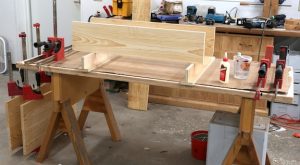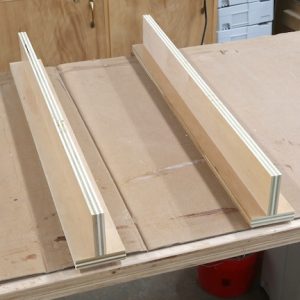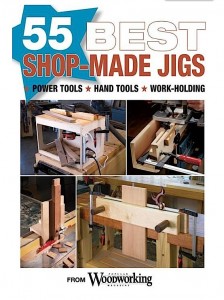We may receive a commission when you use our affiliate links. However, this does not impact our recommendations.
 As you can see, I did get into the shop this week to begin on my workbench storage boxes. The thing I most like about building my own design – after 15 plus years building 18th- and early 19th-Century designs for customers – is that I can change the design clear up until I can’t. After reading a few of the comments in my last post (click here), I have made a couple changes. (Thank you Tom8021 for reminding me about Tage Frid’s books – I went back for a refresher on plywood joinery.)
As you can see, I did get into the shop this week to begin on my workbench storage boxes. The thing I most like about building my own design – after 15 plus years building 18th- and early 19th-Century designs for customers – is that I can change the design clear up until I can’t. After reading a few of the comments in my last post (click here), I have made a couple changes. (Thank you Tom8021 for reminding me about Tage Frid’s books – I went back for a refresher on plywood joinery.)
Changes? I decided that these under-the-bench storage boxes were too deep at 22 1/2″, so I shortened the depth to 15 1/2″.  Also, many of the comments focused on the idea that my workbench storage boxes didn’t need fancy dovetails if they were to always sit under the bench. That’s also a great point. However, I think these boxes can be travel boxes, so I plan to build them out of yellow pine and with dovetailed corners. Also, I’ll add handles to the tops of each box so they are easy to lug around.
Also, many of the comments focused on the idea that my workbench storage boxes didn’t need fancy dovetails if they were to always sit under the bench. That’s also a great point. However, I think these boxes can be travel boxes, so I plan to build them out of yellow pine and with dovetailed corners. Also, I’ll add handles to the tops of each box so they are easy to lug around.
As I began milling the lumber, I was amazed at how difficult it is to work in a shop other than the one you’re use to. I had to locate clamps, snatch glue and borrow a tape measure just to glue-up four panels. In my home shop, I use a pair of T-stands (shown above, right) to elevate my panels as I glue – I find it easier to manipulate my boards if they are off the table or clamps, and if you need to slip a clamp on the underside of your panel, having the boards on stands allows easy access. The stands are so simple to build that you might want to give them a try. Jigs make work quicker and easier.
I use a pair of T-stands (shown above, right) to elevate my panels as I glue – I find it easier to manipulate my boards if they are off the table or clamps, and if you need to slip a clamp on the underside of your panel, having the boards on stands allows easy access. The stands are so simple to build that you might want to give them a try. Jigs make work quicker and easier.
If you are jig-deficient in your shop, you need a copy of the “55 Best Shop-Made Jigs.” You’ll be surprised at how much you get done in your shop.
Here are some supplies and tools we find essential in our everyday work around the shop. We may receive a commission from sales referred by our links; however, we have carefully selected these products for their usefulness and quality.







